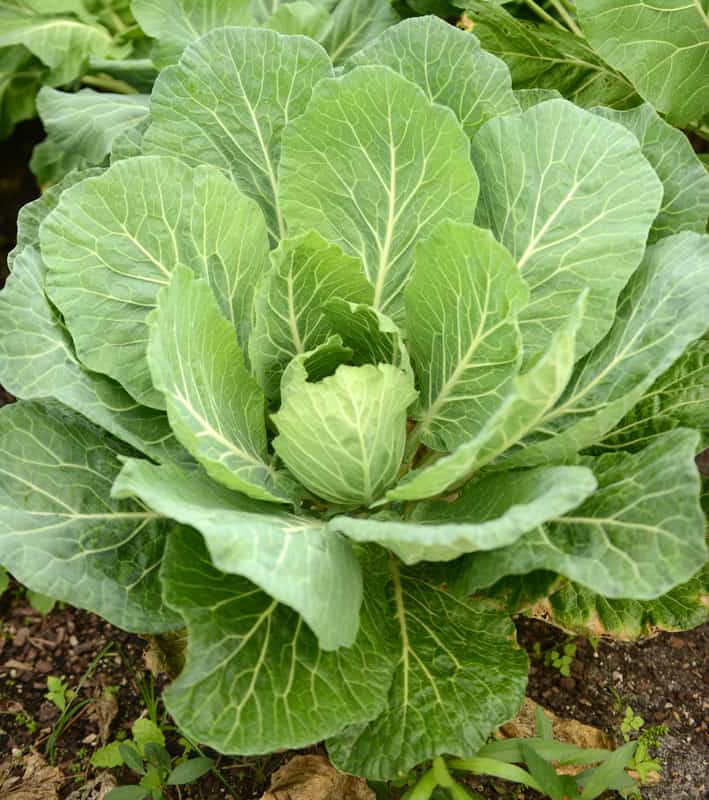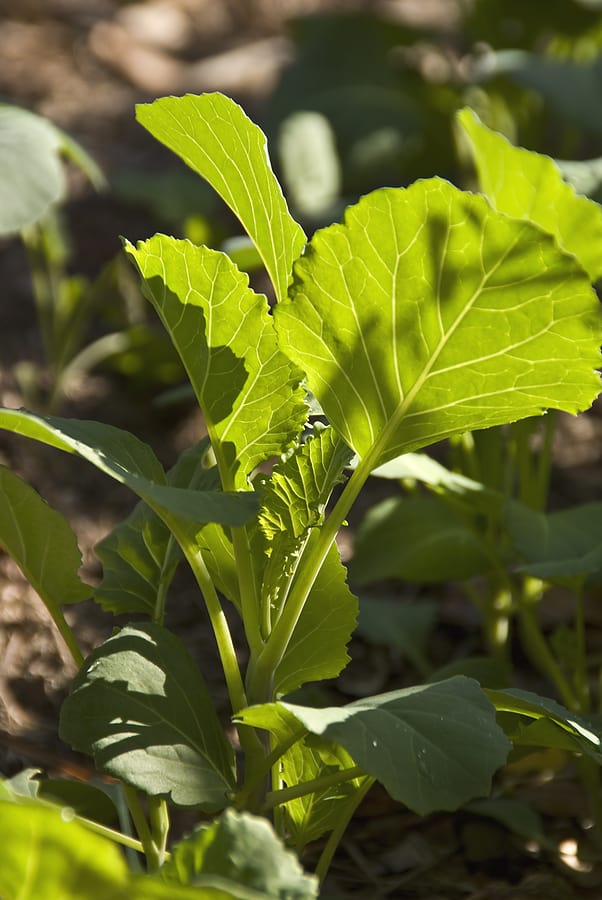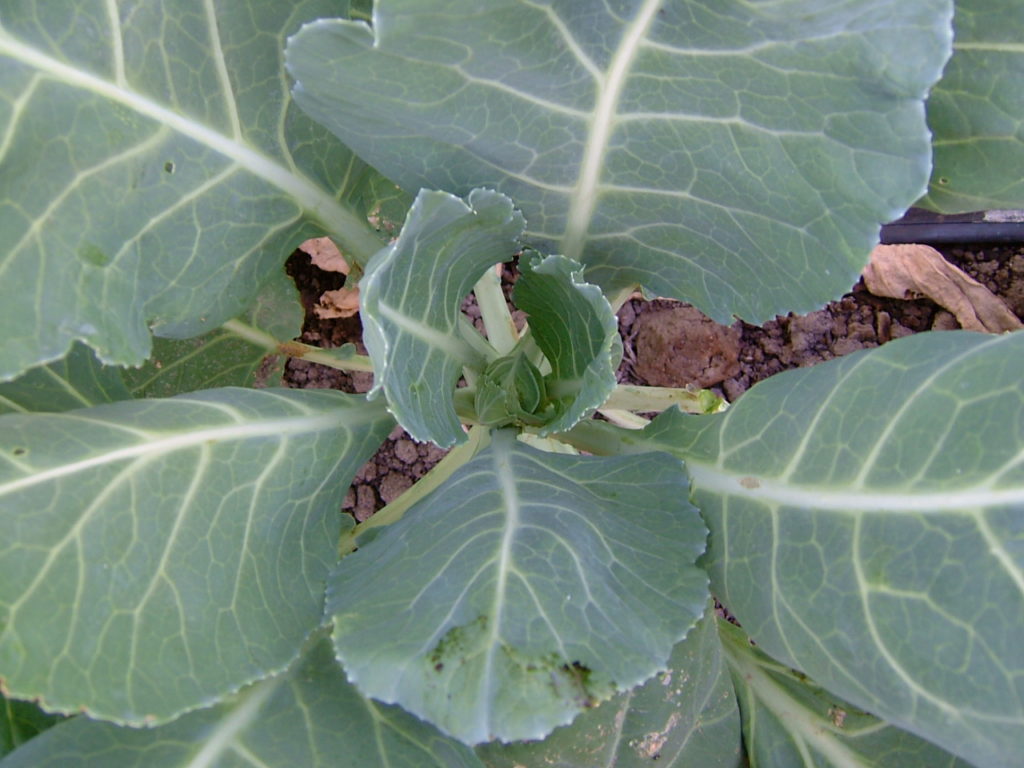Collards–also called collard greens–is a tall growing form of kale whose coarse leaves borne in tufts are eaten like greens. Collards are a cool season crop but they can stand more hot weather than cabbage or ordinary kale, and so are consequently grown in the South.
Georgia collards are the standard variety grown mostly in the South, where seedlings are started like cabbage in February or March for spring use. In the North, for a fall crop, collards are sown in midsummer.
Collards are a hardy biennial grown as an annual. Collards are cultivated like cabbage. Collards grow 2 to 4 feet tall (.6-1.2 m) with rosettes of large, non-heading, light green to dark green to purple waxy leaves growing on short trunk-like stems.
Related articles:
- Five Ways to Cook and Serve Collards
- Collards Seed Starting Tips
- How to Harvest and Store Collards
- How to Plant and Grow Collards

Collards are crowned by a loose cluster of cabbage-like leaves that do not form a head. Collards can be grown as a winter annual in the South by planting seeds in September and transplanting the seedlings to the garden; a harvest of the leaves begins in spring a few at a time. Seeds sown in spring will bear leaves for harvest the following fall or winter.
Collards growing quick tips
- Start seed indoors 4 to 6 weeks before the last frost in spring.
- Sow seed outdoors when the soil can be worked in spring.
- Place transplants in the garden when they are 3 to 4 inches tall (7-10cm) as early as 3 to 4 weeks before the last frost in spring.
- In mild-winter regions, start seed in late summer for a winter or spring harvest.
- Mature plants can withstand temperatures as low as 20°F and as high as 95°F.
- Yield: Plant 2 to 3 collard plants per household member.
Where to plant collards
- Grow collards in full sun. Collards will grow in partial shade.
- Collards prefer well-drained fertile soil rich in organic matter with a soil pH of 6.5 to 7.5. Perform a soil test before planting.
- Add aged compost to planting beds in advance of planting especially where the soil is sandy.
Good Products at Amazon for Raised Bed Growing
- Galvanized Raised Bed 8×3
- Cedar Raised Bed 4×8
- Elevated Cedar Planter 4×2
- Walk-In Greenhouse Tunnel 15x7x7
- Row Cover for Freeze Protection 10×30
Collards planting time
- Collards are a cool-weather crop and can tolerate temperatures as low as 20°F (-6.7°C).
- Collards are more tolerant of heat than cabbage.
- Collards are usually grown from transplants.
- Start seed indoors 4 to 6 weeks before the last frost in spring. Sow seed outdoors when the soil can be worked in spring. Seeds are tiny, dark, and round. Immature leaves sprout from double heart-shaped cotyledons.
- Place transplants in the garden when they are 3 to 4 inches (7-10cm) tall as early as 3 to 4 weeks before the last frost in spring.
- In most regions, collards can be planted in early spring and again in late summer for a fall crop or winter harvest.
- In late summer, directly sow seeds in the garden. In mild-winter regions, start seed in late summer for a winter or spring harvest.
Collardes seed starting
Sow collard seeds in early spring for an early summer crop or in midsummer for a fall crop. In mild-winter regions, sow collards from fall to late winter. Sow seed outdoors 2-4 weeks before the last frost. Start seed indoors 10-8 weeks before transplanting seedlings to the garden. Sow seeds indoors in a warm, well-lighted location—in a bright window or under grow lights. Sow seeds ¼-½” (6-12 mm) deep in seed starting mix; firm lightly and keep mix just moist. Seedlings emerge in 5-10 days at 45-85°F (7-29°C).
Planting collards
Seedlings can be transplanted into the garden when they are 4-5” (10-13 cm) tall 2-4 weeks before the last expected frost in spring and 8-10 weeks before the first frost in fall. Move seedlings to a sheltered place outdoors to “harden off” 1 week before transplanting. Thin plants in the garden 18″ (45 cm) apart in rows 18-24” (45-61 cm) apart. Grow collards in compost-rich, well-drained soil, in full sun. Give collards regular water keeping the soil evenly moist.
- Sow collard seeds 1 inch (2.5cm) deep and 3 inches (7.6cm) apart.
- Thin collards from 12 to 18 inches (30-45 cm) apart when seedlings are big enough to lift by their true leaves. Replant thinned plants in another part of the garden.
- Space rows 24 inches (61cm) apart.
- Transplant thinned seedlings to another part of the garden when plants have 4 or 5 true leaves.
- Transplants that are leggy or have crooked stems should be set deeply up to their first leaves so that they won’t grow to be top-heavy.
- Plants that grow top-heavy may need staking.
- Plants started indoors can be transplanted to the garden 3 to 4 weeks before the last spring frost date. Remove the whole plant from its pot and loosen the root ball before transplanting into the garden.
More tips at: Collard Seed Starting Tips.
Good Products at Amazon for Seed Starting Success:
- Jump Start Germination Station w/Heat Mat Tray, 72-Cell Pack, Dome
- Espoma Seed Starting Mix
- 200 Count- Jiffy 7 Peat Soil Seed Starting Plugs
- Seed Starter Kit with Humidity Dome (120 Cells Total Tray)
- AgrobriteT5 Fluorescent, 2-Foot, Grow Light System
Collards companion planting
- Plant collards with tomatoes, southern peas, and peppers.
- Do not plant with celery, potatoes, or yams.
Container growing collards
- Collards can be grown in containers or grow bags.
- A single plant can be grown in a 10-inch (25cm) pot.
- In larger containers set collards on 18 to 24 inches (45-61cm) centers.

Watering wollards
- Water collards regularly so that leaves do not grow tough. Give collards about 1 to 1.5 inches of water (6.5 gallons) each week.
- Underwatering may cause collards to become stringy.
- Water at the base of collard plants to avoid powdery mildew and damping off.
- Mulch around collards to keep the soil moist.
Feeding collards
- Collards are a heavy feeder; add aged manure or a slow-release organic nitrogen fertilizer to the planting bed in the autumn before planting.
- Side-dress young plants with aged compost early in the season and again at mid-season.
- Give collards monthly supplemental foliar feedings of fish emulsion or seaweed extract.
- Yellowing leaves can be a sign of too little nitrogen.
Blanching collards
- The green leaves of collards can be blanched resulting in a tender texture.
- To blanch collards, when the plants are about 1 foot tall, slip a sturdy rubber band around the whole plant about 8 inches above the soil. Leave the band in place until harvest time. The dark green leaves will turn whitish and tender.
Collards care
- Collards growing in the home garden may need a stake once the plants get leggy and top-heavy.
- If collards bolt (send up a flower stalk) in hot weather, remove the bolting stalks before they flower; cut away the bolt about 1 inch above the growth point of leaves below; use a pruning shear.
- Collards benefit from heavy mulching. Pile chopped leaves or dry grass clippings around collards as fall approaches. Once the ground starts to freeze, cover collards with several chopped leaves to protect plants through the winter.
- Collards that do not get enough light will grow long and spindly.
Good Products at Amazon For Growing Collards and Cabbage Family Crops:
- Neem Bliss 100% Cold Pressed Neem Oil
- Monterey BT Caterpillar Killer
- Safer Brand Insect Killing Soap
- PyGanic Botanical Insecticide
- Captain Jack’s Dead Bug Brew
- Live Ladybugs
- Natures Good Guys Beneficial Nematodes
- Yellow Sticky Traps
- Southern Ag Liquid Copper Fungicide
- MycoStop Biofungicide
Collards pests
- Collards may be attacked by cabbage family pests: aphids, thrips, flea beetle, cutworms, cabbage loopers (preceded by small yellow and white moths), imported cabbage worms, cutworms, and root-knot nematodes.
- Aphids and thrips will suck the juices from leaves; wash them off the plant or control them with neem oil.
- Cabbage loopers (caterpillars) and cabbage worms chew holes in the leaves. Use a row cover to exclude these pests.
- Handpick these pests or spray plants with neem oil or Bacillus thuringiensis.
- Collards grown in cool weather will attract fewer pests than collards grown in warm weather.
Collards diseases
- Collards are susceptible to diseases that strike other brassica family crops: Alternaria, Cercospora, white leaf spot, clubroots, and damping off.
- Downy mildew, leaf spot, and black rot can occur. Avoid overhead watering and make sure the soil is well drained. Plant where there is ample air circulation.
- Alternaria fungi that remain in the soil can cause damping off when new plants appear.
- Remove leaves affected by disease and dispose of them in the trash.
- Avoid soil-borne diseases by rotating cabbage-family members.

Harvesting collards
Collards will be ready for harvest 60-90 days from direct seeding depending upon variety. Clip individual leaves when they reach about 12” (30 cm) long. Do not disturb the central bud when picking he leaves. Pick leaves from the bottom up before they get old and tough. Harvest through winter in most regions; frost makes the leaves taste sweeter. Collards will keep in the refrigerator for about 1 week.
- Collards are ready for harvest 85 to 95 days from seeding and 75 to 85 days from transplanting.
- Pick or cut individual leaves on a cut-and-come-again schedule as soon as plants reach12 inches tall. Leaves 6 to 8 inches long will be the most tender.
- Harvest young, tender leaves from the bottom up; cut leaves with a pruner or snap them off the stalk before they get old and tough. The entire plant can be harvested at any time by lifting it from the soil.
- Frost will cause some of the carbohydrates in the plants to turn to sugar and can make leaves sweeter tasting.
- Complete the harvest before the first hard freeze.
Also see: How to Harvest and Store Collards.
Storing and preserving collards
- Collard leaves can be stored in the refrigerator in a plastic bag for up to one week or in a cold moist place for 2 to 3 weeks.
- Collards can be frozen, canned, or dried. Blanch collard leaves before freezing.
Collards kitchen use
- Collards are served cooked. Cook collards as you would spinach; steamed, braised, stir-fried, sauteed or added to soups and stews.
- All parts of collards are edible though the stalks and ribs are tough if not cooked,
- Collards are a staple food in Africa, Spain, Portugal, and India.
- Leafy green collards are high in calcium, iron, and vitamins A and C.
Collards frequently asked questions
Q: Why grow collards?
A: Collards are a type of primitive kale, some describe collards as a non-heading cabbage. Collards are high in calcium, iron, and vitamins A and C. They do not mind frost and they can endure considerable summer heat, which is why they are so widely grown in the South. Collards are delicious after they have been touched by frost.
Q: When is the right time to plant collards?
A: Sow collards any time during the growing season allowing 80 to 90 days to mature. Hot regions plantings can be made in the summer so that the plant will mature with a touch of frost–which sweetens the leaves. In cold winter regions, plant collards in spring. Early spring to mid-spring plants will bring a summer harvest. In mild-winter regions, plant collards in late autumn for a spring crop. Spring plants will grow more tender than summer-grown plants.
Q: What growing conditions do collards need?
A: Grow collards as you would other members of the cabbage family. Collards want a good supply of phosphorus to thrive.
Q: How are collards harvested?
A: Pull or cut off the lower leaves as needed using the cut-and-come-again method. The tender, central loose head can be harvested, but new collard leaves will not follow.
Q: Will collards grow a second season?
A: Collard plants not lifted entirely from the ground will sprout new leaves the following spring. Collards that are allowed to flower will drop seeds and new plants will appear the following spring.
Collard varieties to grow
- Varieties. ‘Blue Max’ (68 days); ‘Champion’ (60-80 days); ‘Georgia’ (70-80 days); ‘Top Bunch’ (67 days); ‘Vates’ (55-80 days).
Collards seed saving and propagation
- Allow a few strong plants to mature and flower. Small broccoli-like flower heads open to four-petaled yellow flowers.
- Allow flowers to die and dry, then harvest seedpods and place them in a paper bag where they will burst or can be lightly threshed. Separate the seeds from the pod remnants.
About collards
- Common name. Collards
- Botanical name. Brassica oleracea acephala, Brassica oleracea var. viridis
- Family: Brassicaceae (Cruciferae)–cabbage family; other cole crops include cabbage, kale, turnips, kohlrabi
- Growing zones: Collards grow best in USDA Zones 6-10; they are biennial in Zones 7-10; plants cut to the soil in winter will resprout in spring.
- Origin. Europe, Greece; under cultivation for about 2,000 years
Collards articles on Harvest to Table:
How to Plant and Grow Collards
How to Harvest and Store Collards
Five Ways to Cook and Serve Collards
More how to grow articles:
Learn how to plant, grow, and harvest your favorite vegetables. Click below for all you need to know.
- Artichoke
- Arugula
- Asparagus
- Beans, Snap
- Beets
- Broad Beans
- Broccoli
- Brussels Sprouts
- Cabbage
- Cantaloupe — Melons
- Cardoon
- Carrots
- Cauliflower
- Celeriac
- Celery
- Chard
- Chayote Squash
- Chickpeas
- Chicory
- Chinese Cabbage
- Collards
- Corn Salad
- Corn, Sweet
- Cresses
- Cucumbers
- Eggplant
- Endive and Escarole
- Fava Beans
- Florence Fennel
- Garbanzo Beans
- Garlic
- Horseradish
- Jerusalem Artichoke
- Kale
- Kohlrabi
- Leeks
- Lettuce
- Lima Beans
- Melons
- Mizuna
- Mustard Greens
- New Zealand Spinach
- Okra
- Onions
- Parsnips
- Peanuts
- Peas
- Peppers
- Potatoes
- Pumpkins
- Radicchio
- Radishes
- Rhubarb
- Rutabaga
- Salsify
- Shallots
- Sorrel
- Southern Peas
- Soybeans
- Spinach
- Squash, Summer
- Squash, Winter
- Sunchokes
- Sweet Potato
- Swiss Chard
- Taro
- Tomatillo
- Tomatoes
- Turnips
- Watermelon
- Zucchini
Garden Planning Books at Amazon:
- Vegetable Garden Grower’s Guide
- Tomato Grower’s Answer Book
- Vegetable Garden Almanac & Planner
- Kitchen Garden Grower’s Guide Vegetable Encyclopedia
Grow 80 vegetables: KITCHEN GARDEN GROWERS’ GUIDE















